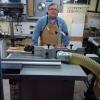I'm making runners/ spacers for window sashes. I'm using 3/4" x 3/8" miter slot stock which is the closest I can get from McMaster-Carr, but it's just a touch too think...I'd like to plane it down about 3/32" to ~.300". Would this stock be too thin and flexible, maybe get picked up by the segmented head? I'd appreciate any thoughts....






 Reply With Quote
Reply With Quote





